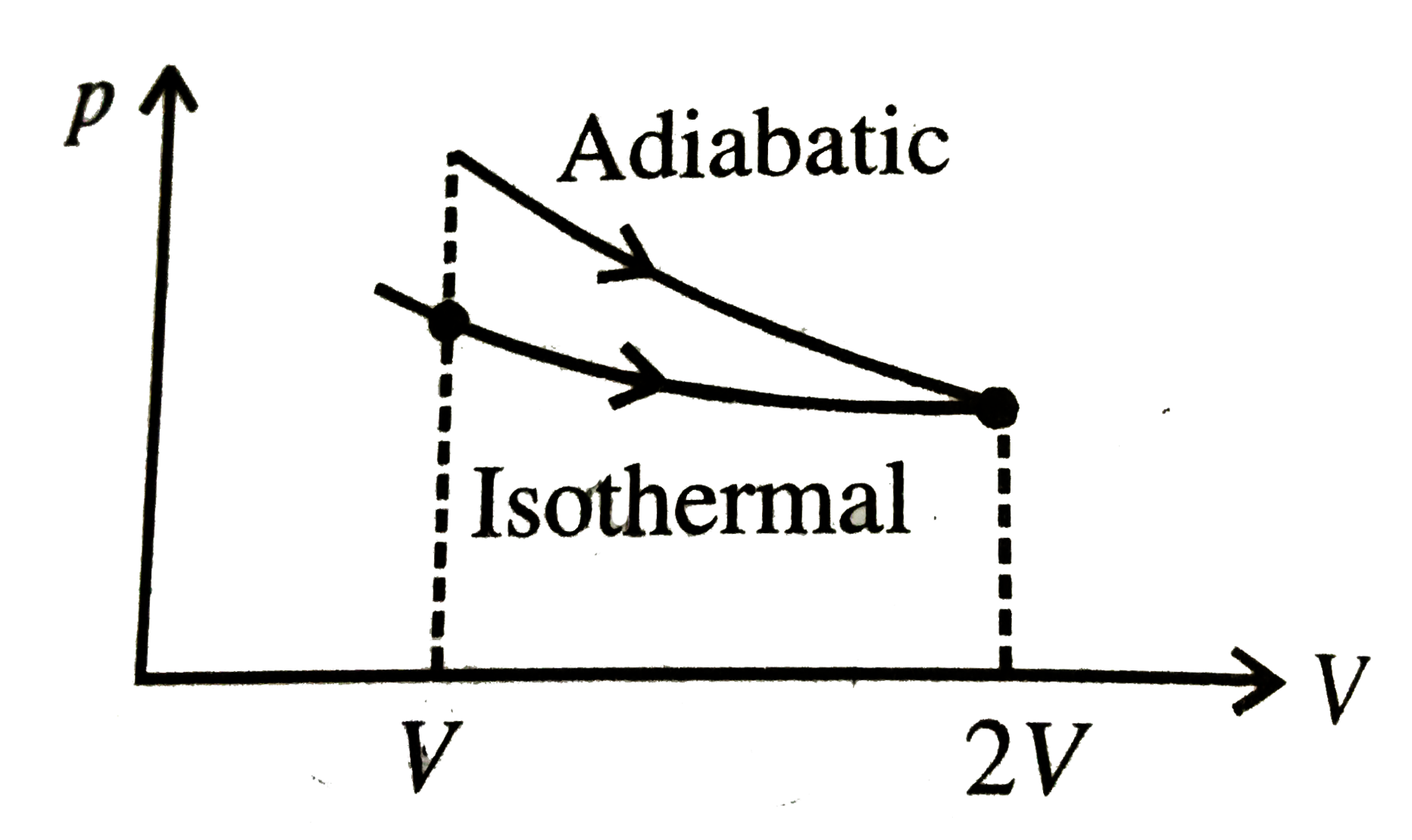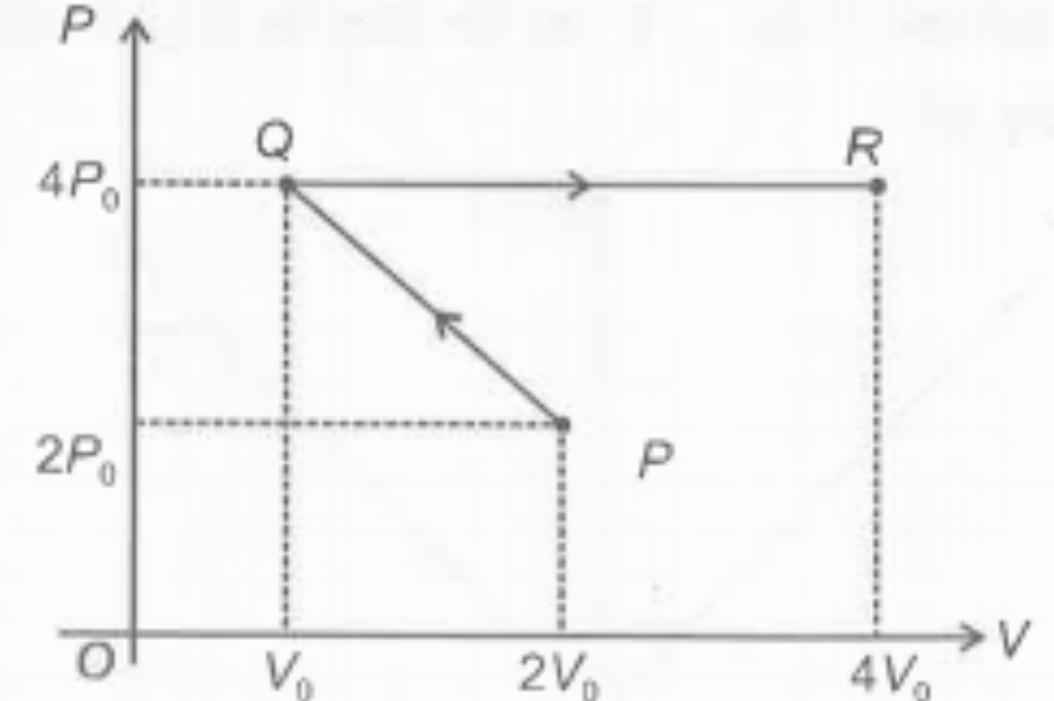A gas may expand either abiabatically or isothermally .A number of P-V curves are drawn for the two processes over different ranges of pressure and volume . It will be found that :
An adiabatic curve and an isothermal curve may intersect
Two adiabatic curves do not intersact
Two isothermal curves do not intersect
All of these
The correct Answer is:D
To analyze the question regarding the behavior of gas during adiabatic and isothermal expansions, we will evaluate each of the four options provided.
1. Understanding Isothermal and Adiabatic Processes:
- An isothermal process occurs at a constant temperature, described by the equation PV=nRT (where n is the number of moles, R is the gas constant, and T is constant).
- An adiabatic process occurs without heat exchange, described by the equation PVγ=constant (where γ is the heat capacity ratio).
2. Option A: An adiabatic curve and an isothermal curve may intersect.
- For an intersection to occur, both curves must satisfy their respective equations at the same P and V.
- In a Carnot cycle, isothermal expansion is followed by adiabatic expansion, indicating that these curves can intersect at a common point.
- Conclusion: This statement is true.
3. Option B: Two adiabatic curves do not intersect.
- If two adiabatic curves were to intersect, it would imply that the same P and V values correspond to two different states of the same gas, which contradicts the uniqueness of state variables.
- Therefore, if they are drawn for different initial conditions (pressure and volume), they cannot intersect.
- Conclusion: This statement is true.
4. Option C: Two isothermal curves do not intersect.
- Each isothermal curve corresponds to a different temperature. For two isothermal processes to intersect, they would need to have the same PV product at the same temperature, which is not possible since they are defined at different temperatures.
- Thus, if they are drawn for different temperatures, they cannot intersect.
- Conclusion: This statement is true.
5. Option D: All of these statements are correct.
- Since options A, B, and C have all been verified as true, option D must also be true.
- Conclusion: This statement is true.
Final Answer:
All of the statements (A, B, C, and D) are correct.
---
- An isothermal process occurs at a constant temperature, described by the equation PV=nRT (where n is the number of moles, R is the gas constant, and T is constant).
- An adiabatic process occurs without heat exchange, described by the equation PVγ=constant (where γ is the heat capacity ratio).
- For an intersection to occur, both curves must satisfy their respective equations at the same P and V.
- In a Carnot cycle, isothermal expansion is followed by adiabatic expansion, indicating that these curves can intersect at a common point.
- Conclusion: This statement is true.
- If two adiabatic curves were to intersect, it would imply that the same P and V values correspond to two different states of the same gas, which contradicts the uniqueness of state variables.
- Therefore, if they are drawn for different initial conditions (pressure and volume), they cannot intersect.
- Conclusion: This statement is true.
- Each isothermal curve corresponds to a different temperature. For two isothermal processes to intersect, they would need to have the same PV product at the same temperature, which is not possible since they are defined at different temperatures.
- Thus, if they are drawn for different temperatures, they cannot intersect.
- Conclusion: This statement is true.
- Since options A, B, and C have all been verified as true, option D must also be true.
- Conclusion: This statement is true.
All of the statements (A, B, C, and D) are correct.
Topper's Solved these Questions
- THERMODYNAMICSBook:AAKASH INSTITUTE ENGLISHChapter:THERMODYNAMICSExercise:ASSIGNMENT (SECTION -C) (Previous Year Questions)
Explore 63 Videos
- THERMODYNAMICSBook:AAKASH INSTITUTE ENGLISHChapter:THERMODYNAMICSExercise:ASSIGNMENT (SECTION -D) (Assertion - Reason Type Questions)
Explore 10 Videos
- THERMODYNAMICSBook:AAKASH INSTITUTE ENGLISHChapter:THERMODYNAMICSExercise:ASSIGNMENT (SECTION -A) (Objective Type Questions)
Explore 47 Videos
- THERMAL PROPERTIES OF MATTERBook:AAKASH INSTITUTE ENGLISHChapter:THERMAL PROPERTIES OF MATTERExercise:Assignment (Section-J) Akash Challengers Questions
Explore 7 Videos
- UNITS AND MEASUREMENTSBook:AAKASH INSTITUTE ENGLISHChapter:UNITS AND MEASUREMENTSExercise:ASSIGNMENT (SECTION - D)
Explore 15 Videos
Similar Questions
Statement I: A gas is expanded from a volume V to 2V, first through adiabatic process then through isothermal process. Work done in isothermal process is more if final state (i.e. pressure and volume ) in both the cases is same.
Statement II: Work done by the gas is equal to area under p−V curve.

View SolutionWhich of the following P-V curve best represents. As isothermal process?
View SolutionAn ideal gas intially has pressure P volume V and temperature T. Its is isothermally expanded to four times of its original volume, then it is compressed at constant pressure to attain its original volume V. Finally, the gas is heated at constant volume to get the original temperature T. (a) Draw V−T curve (b) Calculate the total work done by the gas in the process.(given ln2=0.693)
View SolutionThe pressure p and volume V of an ideal gas both increase in a process.
View SolutionThe pressure P and volume V of an ideal gas both decreases in a process.
View SolutionThree moles of an ideal gas at a pressure PA and temperature TA is isothermally expanded to twice its initial volume. It is then compressed at constant pressure to its original , volume. Finally the gas is compressed at constant volume to its original pressure PA
(a) Sketch the P-V and P-T diagrams for the complete process.
(b) Calculate the net work done by the gas, and net heat supplied to the gas during the complete process.
View SolutionTwo gases have the same initial pressure P, volume V and temperature T. They both expand to the same volume from V to 2V, one adiabatically and the other isothermally. Plot P-V diagram for the given situation and hence explain. In which case is the final temperature greater?
View SolutionThree moles of an ideal gas (Cp=72R) at pressure, PA and temperature TA is isothermally expanded to twice its initial volume. It is then compressed at constant pressure to its original volume. Finally gas is compressed at constant volume to its original pressure PA.
(a) Sketch P-V and P-T diagrams for the complete process.
(b) Calculate the net work done by the gas, and net heat supplied to the gas during the complete process.
View SolutionAn ideal gas at 300K is expanded isothermally to double its volume,then pressure of the gas will be
View SolutionAn ideal gas undergoes a process P→Q→R as shown in pressure (p) - volume (v) diagram.The work done by the gas is

View Solution